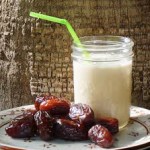By Catharine L. Kaufman (a.k.a. The Kitchen Shrink)
Perhaps this column should be marked PG-13, since much of what’s said about the exotic fruit often called “tree candy,” cannot avoid a slightly suggestive tinge. Starting with its original name: dactylifera, the Greek word for “finger” and later English translation (date), this nutritious progeny of pollinating boy-palms and fruit-bearing girl-palms brings to mind a romantic love story.
 An ancient plant said to have re-energized Mesopotamian desert travelers at oases some eight thousand years ago, date palms thrive in dry, hot climates—such as California’s Coachella Valley—and bear several varieties of fruits. Among the latter are the soft species (Barhee, Halay, Khadrawy and the generously sized and popular Medjool), the somewhat less fleshy ones (Dayri, Deglet Noor and Zahd) and the dry, almost crunchy Thoory.
An ancient plant said to have re-energized Mesopotamian desert travelers at oases some eight thousand years ago, date palms thrive in dry, hot climates—such as California’s Coachella Valley—and bear several varieties of fruits. Among the latter are the soft species (Barhee, Halay, Khadrawy and the generously sized and popular Medjool), the somewhat less fleshy ones (Dayri, Deglet Noor and Zahd) and the dry, almost crunchy Thoory.
To Choose Your Date Wisely… here is a short tutorial:
Nicknamed The Queen of Dates, Deglet Noors are favored for their translucent, amber skin and flesh tinged with delicate honey flavor. Medjools are moist, meaty, each with one small pit; great for snacking or stuffing (with nuts or berries, for example), due to their jumbo size. The small, round Bathis have a caramel candy essence in both texture and flavor. While golden-hued Zahidis are favored for their firmness and toned down  sweetness. The mahogany-dark skinned Khadrawis are soft enough to spread on bread.
sweetness. The mahogany-dark skinned Khadrawis are soft enough to spread on bread.
Their exotic names indicate Middle Eastern and North African provenance—a geography that earned date palms some 50 mentions in the Bible and 20 in the Quran. Honoring their origins, the names were kept unchanged when dates found their way to the New World, to be cultivated in the warm climes of Southern California, Arizona, Southern Florida and south of the U.S. border, in the Sonora and Baja California parts of Mexico.
Courtship Leads to Date Abundance
Once dependent on winds, insects and birds for transporting pollen from male to female palms, horticulturists have developed manual pollination methods, which are not only more reliable, but also allow commercial orchards to plant fewer male and greater numbers of fruit-bearing female trees to maximize yields and profits. Most such orchards plant a ratio of 49 girl trees to one boy tree per acre. As these palm trees grow, ladders are fastened to their trunks so skilled workers could climb to retrieve pollen from the male plants’  long, tendril-like stalks and dust it over female trees’ flowers waiting to be fertilized. (Some growers save labor costs and speed up the process by using wind machines for pollination.)
long, tendril-like stalks and dust it over female trees’ flowers waiting to be fertilized. (Some growers save labor costs and speed up the process by using wind machines for pollination.)
Dates start to ripen in the fall, but since they do so gradually and at different times, harvesters must climb each tree periodically to hand pick the fruits that are ready to eat.
Growing a date palm from planting to commercially viable ‘parenthood’ takes seven to ten years. But once matured, it yields from 150 to 300 pounds of fruit during each harvest cycle. To achieve maximum productivity, however, each heavily packed cluster must be thinned and carefully cocooned in special bags to protect them from insects and birds while they ripen. This tedious process expands the space dates need to grow abundant clusters and fruits of optimum size and plumpness.
A renowned grower, the Shields Date Garden orchard in Indio, California, just east of the resort town of Palm Springs, has been fanning its product’s fame with a theatrical show called  “The Romance and Sex Life of a Date,” which entertains and attract tourists to its shops and café which serves freshly made date shakes and light meals.
“The Romance and Sex Life of a Date,” which entertains and attract tourists to its shops and café which serves freshly made date shakes and light meals.
Dates With Benefits
While weight watchers and diabetics must be careful to enjoy the sweet and chewy fruit in moderation, dates compensate for their sugar content with far more generous amounts of many super-healthy ingredients—which put them without any hesitation in the health-food category.
For starters, dates have more fluid-balancing potassium than bananas; are rich enough in dietary fiber to keep the constitution humming and put the skids on bad cholesterol; are loaded
with immune-boosting anti-inflammatory tannins, Vitamin A, Beta Carotene and Lutein to keep skin radiant, eyes clear and vision sharp; and are a good source of energizing Vitamin B-12. Dates also contain iron for red blood cell production and protection from anemia; calcium, copper, manganese and magnesium for bone and muscle strength; and Vitamin K for balancing blood viscosity (for timely coagulation). These single pit fruits also aid digestion and rev up energy with dextrose  and fructose. The abundance of these and other sugar components—it needs repeating—recommends mindful moderation for weight watchers and diabetics.
and fructose. The abundance of these and other sugar components—it needs repeating—recommends mindful moderation for weight watchers and diabetics.
Abundant nutrition, rich and seductive flavors… no wonder dates have so many delightful culinary uses. They are baked into breads, scones, muffins, cookies, bars and granolas. Dried dates can also be ground into fine flour for gluten-free baking. Nor could anyone find better breakfast and brunch luxuries with which to celebrate red-letter days, than scrumptious smoothies, shakes, flavored yoghurt or oatmeal and mixed-fruit compote. Dates lend caramelized notes to sauces and  dressings, elevate chicken and seafood dishes to gourmet fare, lend extra flair to tabouli, quinoa salad, pilaf and stuffings, make sinful snacks when stuffed with nuts and rolled in chocolate and shredded coconut. And in whatever guise, they do light us up with instant bursts of energy. Interested in recipes for any of the above? Email me at [email protected].
dressings, elevate chicken and seafood dishes to gourmet fare, lend extra flair to tabouli, quinoa salad, pilaf and stuffings, make sinful snacks when stuffed with nuts and rolled in chocolate and shredded coconut. And in whatever guise, they do light us up with instant bursts of energy. Interested in recipes for any of the above? Email me at [email protected].
Cook’s Tip: Dates have a Methuselah shelf life and can be stored in the refrigerator in an airtight container for up to a year. No matter how you serve them, your taste buds will enjoy their
date-dates.


One Comment on “Mating Game of Date Palms”
Contents above are useful to me because I am going for plantation of datepalm season Kharip 2020 .About me Former Lecturer in Crop Science under H.S.C. Voc.Stream at Karmavir Mahavidyalaya Mul Dist. Chandrapur (M.S.)India pin code no.441224 and farmer with land holding 1.28 Hec. at .Chitegaon Mul Dist.Chandrapur educated as M.Sc.Agril.Extension atPGI,AkolaDr.P.D.Agril.University Akola (M.S.)